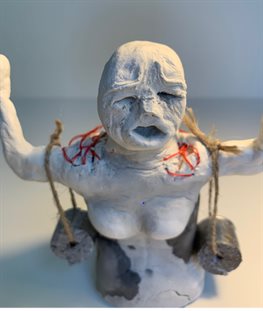The Burden of Chronic Pain
 As part of my 2nd year Student Selected Component project, I explored the representation of chronic pain through art. During my GP placement ran by Kings Undergraduate Medical Education in the Community, I built a positive relationship with a 55-year-old patient who was living with severe polymyalgia rheumatica and fibromyalgia. We decided to co-create artwork that accurately portrays the physical and emotional burden of her condition, from her eyes to my hands, through the medium of sculpture. We had a shared aim to educate people on the lived experience of chronic pain, as it’s something that is rarely taught in medical schools and the reality of the condition is not well understood in society despite it affecting 1/3 of the UK population.
As part of my 2nd year Student Selected Component project, I explored the representation of chronic pain through art. During my GP placement ran by Kings Undergraduate Medical Education in the Community, I built a positive relationship with a 55-year-old patient who was living with severe polymyalgia rheumatica and fibromyalgia. We decided to co-create artwork that accurately portrays the physical and emotional burden of her condition, from her eyes to my hands, through the medium of sculpture. We had a shared aim to educate people on the lived experience of chronic pain, as it’s something that is rarely taught in medical schools and the reality of the condition is not well understood in society despite it affecting 1/3 of the UK population.
I chose sculpture as my medium as I believe it powerfully validates chronic pain by expressing it in a very literal and material way. This is contrasted to many patients’ experiences of pain not being apparent on the outside to society. My patient mentioned she really struggles with this, as she feels not even her own family appreciate how much pain she’s going through. By expressing her pain in a hyperbolic, physicalised form in keeping with societies’s traditional image of pain, I hope to break societal inequalities, helping people realise that chronic pain is indeed real, it is not ‘’all in peoples heads’’ and can be extremely debilitating. It should be taken and treated as seriously as other forms of physical pain.
To represent my patient's physical pain, I used a powerful metaphor she mentioned. She said it feels as if every day as soon as she wakes up, she is carrying dozens of heavy shopping bags, breaking her shoulders and that she is never able to unload those weights. This really helped me to appreciate the perpetual, high intensity suffering her body goes through and how hard she must work to keep going. To portray this metaphor, I used cork and twine as weights, pulling her shoulders down, breaking them apart and curving the back of the sculpture to create a sense of being doubled over in pain. We hope this helps the audience appreciate the immense burden that comes with chronic pain and promote better understanding of the condition.
My patient reflected that she feels like a ‘zombie’, as if her body is constantly falling apart. She has become so dependent on pain medication to subdue her pain that they feel like a temporary fix to her problem and don’t address the root issue. To visualise this, I created patches and cracks around the sculpture sewn together. This really highlights the need for more research into treatment of chronic pain or making resources like CBT therapy and an MDT approach to pain management more readily available as it is shown there is a significant socioeconomic gap in access to pain-management therapy.
Lastly, I’ve represented the effect of chronic pain on mental health by focusing on how the facial expressions of an open-mouthed helpless scream and furrowed eyebrows with tired creases can tell the story of the years of battling with her condition. I hope this emphasises how much the condition has taken away her identity and the pain of not recognising the person she was before her condition. I personally can’t imagine how scary this must be, but I truly hope that our sculpture helps others to have more empathy and understanding toward people living with chronic pain and encourages conversation to break stigmas and misconceptions around the condition.